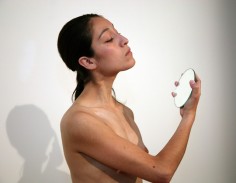Joan Jonas
Джоан Джонас
جوان جوناس
조안 조나스
ジョーン・ジョナス
Mirror Check
source: camhorg
performance work created by Joan Jonas in 1970. The work will run every Saturday at 2PM for the final 8 weeks of Parallel Practices: Joan Jonas & Gina Pane. In Mirror Check, a performer uses a small round hand mirror to inspect all visible portions of her exposed body in reflection. As one of Jonas’ earliest works, Mirror Check marks an important theoretical and artistic turning point for the artist as she transitioned from using mirrors as media in her sculptures to using it as an instrument in her performance. Jonas remarks:
It was a logical development and kind of abstraction of a solo work, standing nude in front of an audience, examining one’s own body with a mirror very slowly. It’s a very simple piece. There is the stipulation that it has to be done by women because that’s how it was originally performed and seen, and meant to be seen because it’s about a woman looking at her own body, having control of that gaze.*
.
.
.
.
.
.
.
.
source: artsynet
The performer observes and examines her own naked body with a small, round hand-held mirror. The mirror serves as a symbol of self-portraiture but also as a device of fragmentation, reflecting parts of the body but not the whole.
.
.
.
.
.
.
.
sorce: artsynet
Joan Jonas, believing that sculpture and painting were exhausted mediums, became known for her pioneering work in performance and video art. Jonas, who studied sculpture and art history, was deeply influenced by the work of Trisha Brown, with whom she studied dance, as well as John Cage and Claes Oldenburg, particular in their exploration of non-linear narrative structure and form. Jonas’s own work has frequently engaged and questioned portrayals of female identity in theatric and self-reflexive ways, using ritual-like gestures, masks, mirrors, and costumes. Over time, Jonas began to introduce more symbolic elements into her work; frequent motifs include dogs, the sun and moon, skulls, landscapes, and hurricanes. Themes of memory, autobiography, mythology, and dreams became more central themes in her work in the 1980s.


